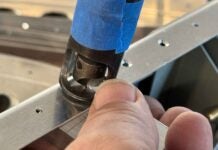
Before I delve into this month’s project, here’s the backstory on where it came from: I started my flight training with 10 hours in a Piper Tomahawk at Brackett Field in La Verne, California. Later (25 years to be exact), in 2007 I resumed my training at Fullerton Municipal Airport, where I took lessons in both a Flight Design CTS and a Remos GX. Unfortunately, this was during the economic downturn of 2008 and after a handful of flights, the flight school folded.
Not long after, I read about the Foothill Flying Club at Cable Airport in Upland and the opportunity to train in a brand-new Gobosh G700S (the USA S-LSA variant of the Polish-built AT-4). With instructor Rick Strack, I completed my flight training and fulfilled my dream of becoming a licensed pilot.

I continued to rent and fly the club’s Gobosh for the better part of the next two years. All in all, it was a pretty cool aircraft. One magazine reviewer said at the time, “The Gobosh excels in clever details (such as) the dipstick on the fuel cap for easy reading.”
I always thought the fuel cap dipstick was a great idea. The fuel tank on the Gobosh was between the cockpit and the engine. While having one central tank was convenient for filling up (versus two wing tanks), it was not so easy to see inside the tank to confirm the fuel level. The factory-attached aluminum dipstick—it was maybe 10 inches long by two inches wide—more or less solved the problem. (A Google search of “Gobosh excels in clever details” will pop up an image of what I’m talking about.)

The Gobosh dipstick had one flaw: It was almost impossible to read in direct sunlight. If you could get it under some shade you could read it, but you had to move fast before the fuel evaporated. If you didn’t mind the smell of gasoline, you could feel where the fuel was with your finger. But the lingering smell of gasoline can be discomforting (…is that a fuel leak or my smelly finger?).


Fast forward to 2021 and I am doing a preflight on my Jabiru. I remove the fuel caps on each tank and use my shop-made dipstick to check the fuel level. I made the dipstick in 2011 for my first airplane, the Victor Stanley-built Funkist (a Teenie-Two variant). The Funkist fuel tank is between the engine and cockpit and is a relatively deep tank, so you need a dipstick to confirm the exact fuel level. When I made the dipstick, I sandblasted it with the idea that fuel clinging to a matte surface would be easier to read. It works great, even in bright sunlight. Later, when I got the Jabiru, I added a second set of graduation marks on it to correspond to the shallower profile of the Jabiru’s wing tanks. As I was putting the dipstick away, it flashed into my head: Why not add dipsticks to my fuel caps, like the Gobosh? Yes, the Jabiru tanks are shallow wing tanks and the fuel cap is completely different, but the caps have a stem/extension for attaching a wire grounding tether, which proved to be ready-made for attaching a dipstick. It’s so simple, I don’t know why I didn’t think of it before!




















should send this to Jabiru to make standard on all their new aircraft or options to put on existing ones. I’m sure Jamie at Jabiru would love to hear from you about this.